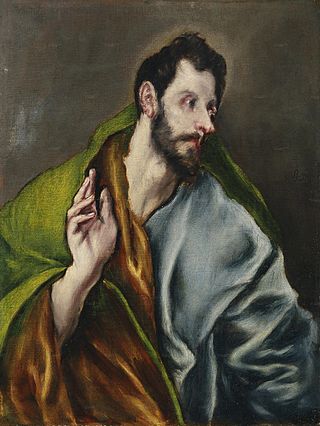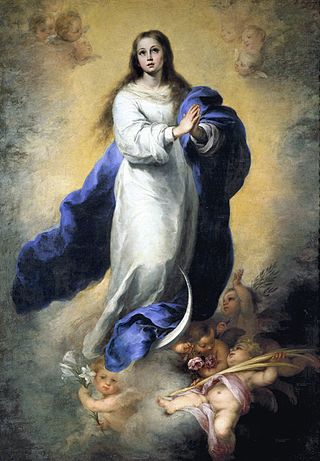
Doménikos Theotokópoulos, most widely known as El Greco, was a Greek painter, sculptor and architect of the Spanish Renaissance. El Greco was a nickname, and the artist normally signed his paintings with his full birth name in Greek letters often adding the word Κρής, which means "Cretan" in Ancient Greek.

In art, a Madonna is a representation of Mary, either alone or with her child Jesus. These images are central icons for both the Catholic and Orthodox churches. The word is from Italian ma donna 'my lady' (archaic). The Madonna and Child type is very prevalent in Christian iconography, divided into many traditional subtypes especially in Eastern Orthodox iconography, often known after the location of a notable icon of the type, such as the Theotokos of Vladimir, Agiosoritissa, Blachernitissa, etc., or descriptive of the depicted posture, as in Hodegetria, Eleusa, etc.

The Pietà is a subject in Christian art depicting the Blessed Virgin Mary cradling the dead body of Jesus Christ after his Descent from the Cross. It is most often found in sculpture. The Pietà is a specific form of the Lamentation of Christ in which Jesus is mourned by the Virgin Mary alone. However, in practice works called a Pietà may include angels, the other figures usual in Lamentations, and even donor portraits.

Francisco de Zurbarán was a Spanish painter. He is known primarily for his religious paintings depicting monks, nuns, and martyrs, and for his still-lifes. Zurbarán gained the nickname "Spanish Caravaggio", owing to the forceful use of chiaroscuro in which he excelled.

The Assumption of the Virgin Mary does not appear in the New Testament, but appears in apocryphal literature of the 3rd and 4th centuries, and by 1000 was widely believed in the Western Church, though not made formal Catholic dogma until 1950. It first became a popular subject in Western Christian art in the 12th century, along with other narrative scenes from the Life of the Virgin, and the Coronation of the Virgin. These "Marian" subjects were especially promoted by the Cistercian Order and Saint Bernard of Clairvaux.

Dormition of the Virgin is a tempera painting on panel executed by El Greco near the end of his Cretan period, probably before 1567. El Greco's signature on the base of the central candelabrum was discovered in 1983. The discovery of the Dormition led to the attribution of three other signed works of "Doménicos" to El Greco and then to the acceptance as authentic of more works, signed or not.

The Assumption of the Virgin is an oil on canvas painting by Greek artist Doménikos Theotokópoulos, known as El Greco, in 1577–1579. The painting was a central element of the altarpiece of the church of Santo Domingo el Antiguo in Toledo, Spain. It was the first of nine paintings that El Greco was commissioned to paint for this church. The Assumption of the Virgin was El Greco's first work in Toledo and started his 37-year career there. Under the influence of Michelangelo, El Greco created a painting that in essence was Italian, with a naturalistic style, monumental figures, and a Roman school palette. The composition of El Greco's depiction of the Assumption of the Virgin resembles Titian's Assumption in the Basilica dei Frari in Venice with Virgin Mary and angels above and the apostles below. On the painting Virgin Mary floats upward which symbolizes her purity, while apostles gathered around her empty tomb express amazement and concern.

The Disrobing of Christ or El Expolio is a painting by El Greco begun in the summer of 1577 and completed in the spring of 1579 for the High Altar of the sacristy of the Cathedral of Toledo, where it still normally hangs. In late 2013 it was on temporary display at the Prado in Madrid, following a period of cleaning and conservation work there; it was returned to Toledo in 2014. It is one of El Greco's most famous works. A document dated July 2, 1577 which refers to this painting is the earliest record of El Greco's presence in Spain. The commission for the painting was secured thanks to El Greco's friendship from Rome with Luis, the son of Diego de Castilla, the dean of the Cathedral of Toledo. De Castilla senior also arranged El Greco's other major commission, on which he worked simultaneously, the paintings for the Toledan church of Santo Domingo el Antiguo.

Christ Carrying the Cross on his way to his crucifixion is an episode included in the Gospel of John, and a very common subject in art, especially in the fourteen Stations of the Cross, sets of which are now found in almost all Roman Catholic churches, as well as in many Lutheran churches and Anglican churches. However, the subject occurs in many other contexts, including single works and cycles of the Life of Christ or the Passion of Christ. Alternative names include the Procession to Calvary, Road to Calvary and Way to Calvary, Calvary or Golgotha being the site of the crucifixion outside Jerusalem. The actual route taken is defined by tradition as the Via Dolorosa in Jerusalem, although the specific path of this route has varied over the centuries and continues to be the subject of debate.

Christ taking leave of his Mother is a subject in Christian art, most commonly found in Northern European art of the 15th and 16th centuries. Christ says farewell to his mother Mary, often blessing her, before leaving for his final journey to Jerusalem, which he knows will lead to his Passion and death; indeed this scene marks the beginning of his Passion. In early versions just these two figures are usually shown, at half-length or less.

The life of Christ as a narrative cycle in Christian art comprises a number of different subjects showing events from the life of Jesus on Earth. They are distinguished from the many other subjects in art showing the eternal life of Christ, such as Christ in Majesty, and also many types of portrait or devotional subjects without a narrative element.

The Nobleman with his Hand on his Chest is an oil painting by El Greco, one of the earliest works painted by the artist in Spain.

Holy Family is a 1586-1588 oil on canvas painting by El Greco, painted during his time in Toledo and now in that city's Museum of Santa Cruz.

The Immaculate Conception with Saint John the Evangelist is an oil painting on canvas of c. 1585 by El Greco, depicting the Virgin of the Immaculate Conception with Saint John the Evangelist.

Christ Carrying the Cross is an oil painting by El Greco, produced early in his Toledo period circa de 1580. The picture depicts Christ in a moment of personal reflection as he carries the cross to his death, therefore committing the ultimate sacrifice for humankind. In the painting, Christ's eyes are lifted up to the heavens as he begins his walk towards his crucifixion. His gentle hands wrap around the cross as a stormy night floods the background. Christ Carrying the Cross is an oil painting, 105x79cm. The painting, one of numerous similar paintings by El Greco, is currently in the El Greco room in the New York art collection of the Metropolitan Museum of Art.

The Fable is a 1580 allegorical painting by El Greco, produced early in his Toledan period and now in the Museo del Prado in Madrid.

Saint Jerome is a 1609 painting by El Greco, now in the Frick Collection, New York.

Saint Thomas the Apostle is a 1608–1614 painting of Thomas the Apostle by El Greco, now in the Museo del Prado.

The Immaculate Conception of El Escorial is a circa 1660–1665 oil religious painting by the Spanish Baroque artist Bartolomé Esteban Murillo, now in the Museo del Prado in Madrid. Murillo's many artistic depictions of the Immaculate Conception of the Virgin Mary were enormously influential on later art. This painting is regarded as one of his best. It was earlier identified as the Immaculate Conception of the Granja due to a mistaken understanding of its history.



















